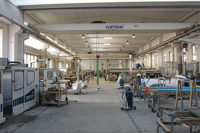They found that clients were pleased with the aesthetics of antique granite, and the engineers who designed these elevated systems favored the idea of using granite for its weight, mass and structural integrity. Shortly thereafter, local supplies became exhausted. Consequently, the firm set out to establish its own supply lines, and Olde New England Granite (ONEG) was formed.
The company sought other avenues to find large sources of block material to ultimately be used in constructing its "breakout" retaining walls. And while doing so, a business decision was made to also become a supplier of reclaimed granite to the public.
Initial contacts made by The Reed Corp.'s staff were to those who had surplus granite from projects that needed to either be removed or reclaimed -- from demolition sites, road and bridge projects, old quarries or even from an old granite dump. These opportunities included procuring bridge and foundation blocks, and they also came across cobblestones, curbing, pavers and old mill pieces.
Establishing the "Granite Farm"
ONEG created its "Granite Farm" to be the base of operations. "People ask, when hearing about our Granite Farm, 'Is that where you grow your granite?'" said Biz Reed, Executive Vice President/COO of ONEG. "We like the term because the property where we have our Granite Farm was indeed a farm years ago. So, 'Granite Farm' seemed like an appropriate description for our yard. It ties our past and our present. We like the uniqueness of it, and we actually use farming terminology when we get with contractors. For example, I like to use the term 'harvesting' when we are out retrieving granite material from different sites. What sounds greener than this? We're out harvesting cobblestones. Chances are there is probably not another facility east of the Mississippi that uses the term the 'Granite Farm.' "
ONEG maintains an extensive inventory at its Granite Farm. The company harvests cobblestones, granite paving blocks, old quarried veneer, wall building material, curbing and reclaimed pier and bridge blocks, to name just a few products. They also have historic foundation pieces, monuments, posts, steps and landings. Along with this inventory, which is always kept in rotation, finished feature pieces are on display throughout the Granite Farm, including an outdoor granite shower with attached water feature, an antique granite post-and-rail fence, a mixed material mosaic retaining wall, archways, a "Stonehenge collection," "granite and green treatments" and privacy hedges, among other products. These applications showcase potential finished hardscape and landscape settings.
One noteworthy application of ONEG's inventory is that of cemetery headstone pieces. "We like to call them 'old quarried -- natural headstone pieces,' " said Reed, commenting on the popularity of this usage. "People generally think that you need to buy a new piece of granite to use for individual monuments. But in actuality, you can take one of our aged and weathered pieces, appropriately sized, have it engraved or put a plaque on it for a fraction of the cost. It is usually the simplicity and uniqueness of these one-of-a-kind stones that is the attraction here. For many, simple and natural seems to feel more appropriate."
Building a network
ONEG has established a solid network among construction and demolition industry personnel that allows them to usually know where other materials are -- or when they are scheduled to be available -- and how quickly they can get it themselves. So far, ONEG has been successful in generating and keeping material both for larger and smaller scale projects, reports the company.
Steps and landings are currently its best sellers, and keeping a large volume of reclaimed block material in inventory allows ONEG to keep up with the strong demand. The company is currently working with three fabricating firms, which are providing sawing and thermal-finishing services to ONEG. Through combined efforts, they are now creating an extensive array of products -- with steps and landings at the forefront.
In addition to treads and landings, ONEG is also creating a wide range of other sawn and thermal-finishing products, including picnic tables, chairs, benches, patio/walkway pavers and a variety of thin stone products for indoor and outdoor applications. Moreover, ONEG custom splits posts and columns by hand using the old "feather and wedge" splitting technique. "It keeps us in touch with how all this granite was originally quarried decades ago," said Reed.
Historic reclamation projects
An example of ONEG's latest historical reclamation project consisted of transferring granite to the Granite Farm from the Essex Merrimack Drawbridge in Amesbury, MA. Originally built in 1882, the bridge's structure once spanned the Merrimack River and was roughly 250 feet in length. Its three mammoth abutments were constructed with granite hailing from local -- now defunct -- quarries which yielded the once-famous and still widely popular Cape Ann-Rockport granite material. Unfortunately, the bridge's structural integrity was compromised when struck by a vessel a few years ago. The decision was made to remove and replace this historic bridge with a new superstructure. "We're bringing it all back," said Reed. "After all, isn't this just what the recycling process is all about? We are really just scratching the surface as the green movement marches forward. We feel like our projects are going forth, too. There are more and more green projects out there and more and more people are designing with reclaimed material. People look to us because they know we are reclaiming granite. The material we have has mass appeal. Contractors, architects and urban planners know what we have and know what we do with it; the major players seem to have found us."











